| Klungkung
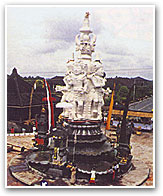 The
district of Klungkung has played a most important role in
Bali’s history. It was the seat of rule of Bali’s history. It
was the seat of rule of Bali’s most powerful dynasty of rajas,
the Dewa Agung, under whom the island was united during a
glorious period of rich cultural influence. Gajah Mada, head
of Majapahit, pacified and united Bali towards the end of the
13th century, incorporating the island into the
Majapahit Empire. He set king Kepakisan, the first Dewa Agung
"Great Deity". To rule over the island from his court at
Samprangan, near the present town of Klungkung. Several
generations later this seat of power was removed to nearby
Gelgel, where it established much authority and prestige under
the fourth succeeding Dewa Agung. The
district of Klungkung has played a most important role in
Bali’s history. It was the seat of rule of Bali’s history. It
was the seat of rule of Bali’s most powerful dynasty of rajas,
the Dewa Agung, under whom the island was united during a
glorious period of rich cultural influence. Gajah Mada, head
of Majapahit, pacified and united Bali towards the end of the
13th century, incorporating the island into the
Majapahit Empire. He set king Kepakisan, the first Dewa Agung
"Great Deity". To rule over the island from his court at
Samprangan, near the present town of Klungkung. Several
generations later this seat of power was removed to nearby
Gelgel, where it established much authority and prestige under
the fourth succeeding Dewa Agung.
With the collapse of the Majapahit Empire
in 1515, many thousands of Javanese Hindus, priests, nobles
and entire followings of soldiers, artists and artisans fled
the onslaught of Islam in Java. Pledging their services to the
current Dewa Agung they settled in Bali, bringing fresh
impetus to the already strongly Hinduism culture.
The 16th century was a golden
age for Bali. Under the wise rule of Dalem Waturenggong from
his court at Gelgel the island became a strongly unified
kingdom, so powerful it was able to conquer and colonize both
Lombok and Sumbawa. Under the auspices of the royal court the
transplanted Javanese traditions of language and literature,
music, dance and sculpture, took firm root. The philosophy
fitted perfectly over the beliefs and practices of the
people.
Gelgel’s period of peace and prosperity
was not fated to last, however. Under the rule of
Waturenggong's grandson, Di Made, who misused his power to an
extreme, the outlying colonies were lost, as well as much of
the allegiance of the other Balinese princes. He flirted with
the Dutch, and made himself so unpopular in his lifetime that
his successor decided the place of Gelgel must be under a
curse, and moved his entire court to a new site in Klungkung
in 1686.
Although the Raja of Klungkung was still
considered by the regional king’s the supreme ruler of Bali,
he had little political power, and the structure of the many
little kingdoms was more like a confederation at this stage.
However, the Klungkung court continued to play a major role in
government, diplomacy and the arts. Most of Bali’s nobility
are descendants of this royal lineage. Along with the other
kingdoms, the Dewa Agung fought the Dutch to the bitter end,
leading a ceremonial "puputan" in 1908 after heavy bombardment
of both Klungkung and Gelgel by the Dutch artillery. This was
the final conquest for the Dutch, giving them control over all
of Bali.
A Region of
Contrasts
East Bali is very different to the lush
plains and bustling towns of the south. A narrow coastal strip
of coconut and banana plantations alternates with pockets of
fertile rice fields, behind which sharp peaks tower, the
foothills that lead back to the colossal peak of Mount Agung.
Palms-fringed beaches look across a narrow strait to the
island of Nusa Penida, Nusa Lembongan and Nusa Ceningan once a
penal colony and still a major part of the district of
Klungkung.
The town of Klungkung is bordered by the
stony Unda River, with its great expanse of weirs that protect
the surrounding villages at flood times. Further east the
landscape is still scarred by the black lava streams of 1963’s
eruption, which entirely cut the area of from the rest of Bali
for quite some time. The pace of life is quite, and in the
little coastal fishing villages and hillside communities
barely accessible by road, life is little disturbed by the
pace of the 20th century.
Places of
Interest
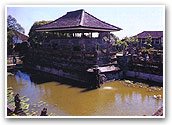 Kertha Gosa
and Taman Gili, the Royal Courts of Justice of Klungkung, are
a reminder of the power and glory of this former kingdom These
two stately pavilions in their lotus pond gardens at the
centre of the town of Klungkung, were built in the
18th century, at which time they acted as the
island’s highest court of law. Their fantastic ceiling murals
in the traditional "Wayang" style of painting depict the
punishments in hell for wrong-doers, as well as the rewards
heaven for those who are good and honest in their lifetime, a
highly evocative view of the Balinese belief in "Kamapala"
every action bears fruit, be it good or bad. Judgments were
made according to traditional law by three Brahmana high
priests. During Dutch colonial rule the courts were still held
here, pronouncing judgments on cases concerning custom and
traditional law which could not be settled at the village
level. Meetings were also held during the full moon of every
fourth month of the Balinese calendar, attended by the
regional king’s throughout Bali, wherein the high king of
Klungkung gave his directives and decisions concerning the
problems of the greater Kingdom of Bali. The hall of Kertha
Gosa was also often used for audiences granted to guests and
foreigners by the king. Kertha Gosa
and Taman Gili, the Royal Courts of Justice of Klungkung, are
a reminder of the power and glory of this former kingdom These
two stately pavilions in their lotus pond gardens at the
centre of the town of Klungkung, were built in the
18th century, at which time they acted as the
island’s highest court of law. Their fantastic ceiling murals
in the traditional "Wayang" style of painting depict the
punishments in hell for wrong-doers, as well as the rewards
heaven for those who are good and honest in their lifetime, a
highly evocative view of the Balinese belief in "Kamapala"
every action bears fruit, be it good or bad. Judgments were
made according to traditional law by three Brahmana high
priests. During Dutch colonial rule the courts were still held
here, pronouncing judgments on cases concerning custom and
traditional law which could not be settled at the village
level. Meetings were also held during the full moon of every
fourth month of the Balinese calendar, attended by the
regional king’s throughout Bali, wherein the high king of
Klungkung gave his directives and decisions concerning the
problems of the greater Kingdom of Bali. The hall of Kertha
Gosa was also often used for audiences granted to guests and
foreigners by the king.
A tall gateway behind Kerta Gosa once led
into Bali’s most splendid palace, which was destroyed in the
Dutch bombardments of 1908 that resulted in the conquest of
the island. A memorial to this terrible this terrible Puputan
battle that ended 600 years of glorious rule in Bali by the
descendants of Majapahit, has been erected on the eastern side
of regent’s office , across the road from Kertha Gosa.
At the western side of the Kertha Gosa
pavilions is Taman Gili which was previously the headquarters
of the king’s guard. Restored during Dutch times, this
pavilions is decorated in more recent "Wayang" paintings, by
the best o the Kamasan school of Artists. The ceiling of this
moated pavilion describes the Balinese horoscopes, as well as
illustrating a number of folk tales from old literary
classics.
Kamasan
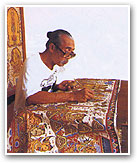 A few
kilometers to the south of Klungkung, past the town of Gelgel,
lies the village of Kamasan, the centre of traditional "Wayang" painting. This village is also famous for its gold
and silver smiths who make hand beaten bowls and trays used in
religious ceremony all over the island. A few
kilometers to the south of Klungkung, past the town of Gelgel,
lies the village of Kamasan, the centre of traditional "Wayang" painting. This village is also famous for its gold
and silver smiths who make hand beaten bowls and trays used in
religious ceremony all over the island.
Goa
Lawah
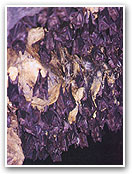 The road
past Klungkung runs parallel to magnificent seascapes black
sand beaches pounded by turbulent swirling waters. Just 6
kilometers east of the town is the temple and cave Goa Lawah,
"The Bat Cave", where shrines cluster around the entrance to a
cave which is said to extend all the way under ground to a
small temple Pura Goa, in the Besakih complex, right on the
slopes of mount Agung. This cave is said to be the dwelling of
the mythological naga serpent, Basuki, who is honored by a
small shrine within the temple. The road
past Klungkung runs parallel to magnificent seascapes black
sand beaches pounded by turbulent swirling waters. Just 6
kilometers east of the town is the temple and cave Goa Lawah,
"The Bat Cave", where shrines cluster around the entrance to a
cave which is said to extend all the way under ground to a
small temple Pura Goa, in the Besakih complex, right on the
slopes of mount Agung. This cave is said to be the dwelling of
the mythological naga serpent, Basuki, who is honored by a
small shrine within the temple.
A round the mount of the cave cluster
thousands of bats, their high-pitched squeaks filling the air
, tiny quivering bodies packed together in an undulating mass.
As with many strange natural phenomena, this cave and its
temple are considered very holy by all Balinese, and groups of
devotees come with offerings to complete their post-cremation
"Segara Gunung" ceremonies for the soul of their
deceased.
Nusa Penida,
Lembongan & Ceningan
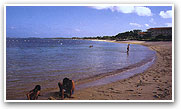 Two thirds
of the land in the Klungkung district is on the island of Nusa
Penida, Nusa Lembongan and Nusa Ceningan. The largest of
these, Nusa Penida once a penal colony, has been stripped of
its original teak forests and jungle, resulting in a barren,
dry hilly terrain. Recent government agricultural projects
have started a "greening" programme, providing "lontoro",
cashew and "gamal" trees to plaint. The people of Nusa are
great cow breeders, and there are more than two cows for every
family on the island. These sleek, well-fed animals, closely
resembling dear, are packed onto large outrigger canoes and
shipped over to Sanur where they are sold for local beef
consumption and export. Two thirds
of the land in the Klungkung district is on the island of Nusa
Penida, Nusa Lembongan and Nusa Ceningan. The largest of
these, Nusa Penida once a penal colony, has been stripped of
its original teak forests and jungle, resulting in a barren,
dry hilly terrain. Recent government agricultural projects
have started a "greening" programme, providing "lontoro",
cashew and "gamal" trees to plaint. The people of Nusa are
great cow breeders, and there are more than two cows for every
family on the island. These sleek, well-fed animals, closely
resembling dear, are packed onto large outrigger canoes and
shipped over to Sanur where they are sold for local beef
consumption and export.
The islands of Nusa Penida and Lembongan
were "discovered" by a group of traveling surfers nearly a
decade ago, and the beach of Jungut Batu has now become well
known in surfing circles all over the world. Conditions here
are also perfect for skin diving.
|

